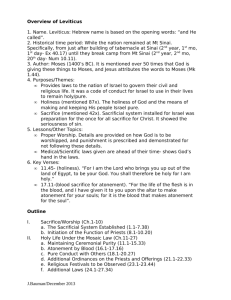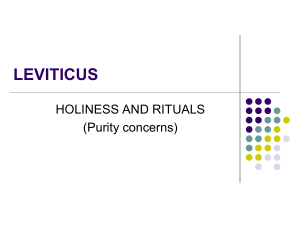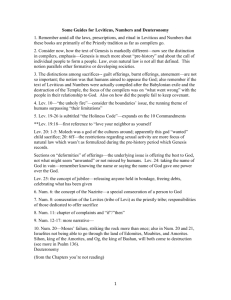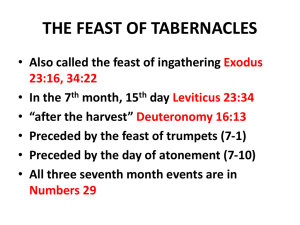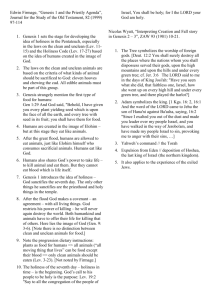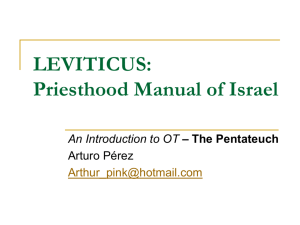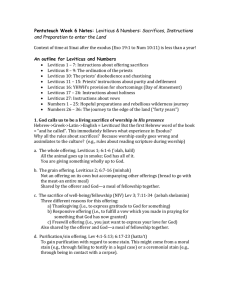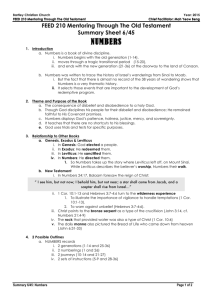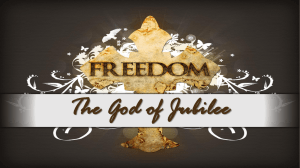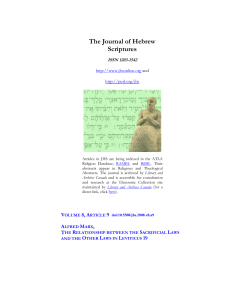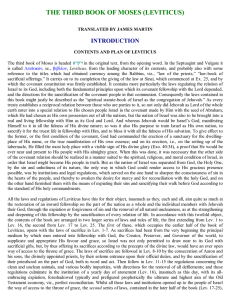Leviticus Primer - Gordon College Faculty
advertisement
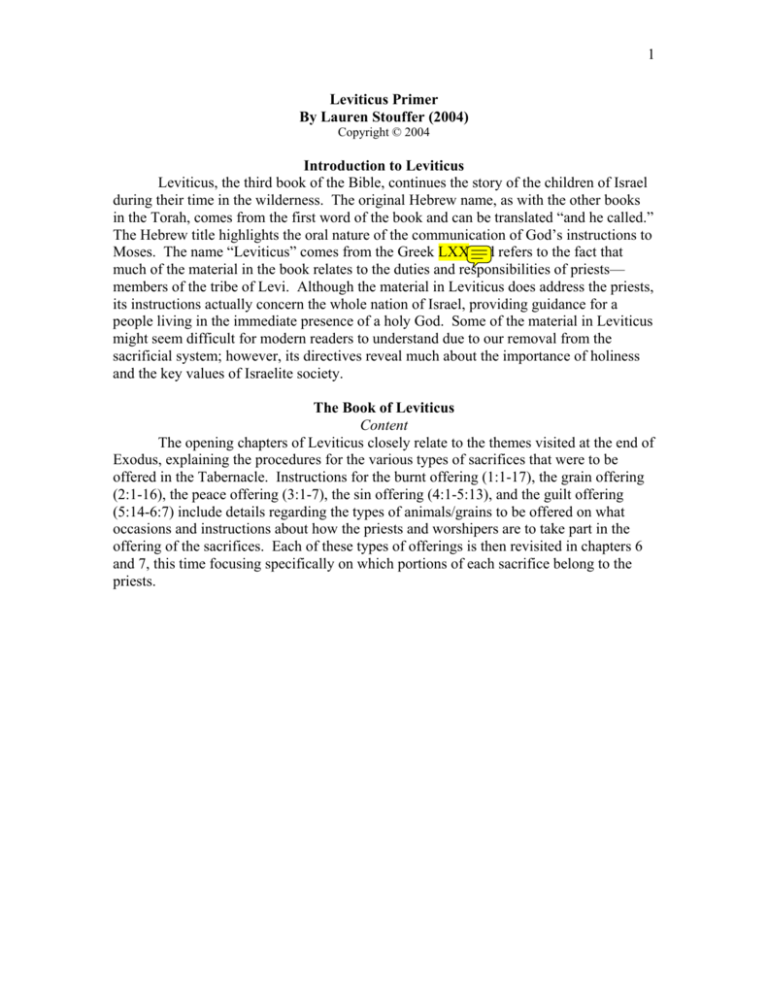
1 Leviticus Primer By Lauren Stouffer (2004) Copyright © 2004 Introduction to Leviticus Leviticus, the third book of the Bible, continues the story of the children of Israel during their time in the wilderness. The original Hebrew name, as with the other books in the Torah, comes from the first word of the book and can be translated “and he called.” The Hebrew title highlights the oral nature of the communication of God’s instructions to Moses. The name “Leviticus” comes from the Greek LXX and refers to the fact that much of the material in the book relates to the duties and responsibilities of priests— members of the tribe of Levi. Although the material in Leviticus does address the priests, its instructions actually concern the whole nation of Israel, providing guidance for a people living in the immediate presence of a holy God. Some of the material in Leviticus might seem difficult for modern readers to understand due to our removal from the sacrificial system; however, its directives reveal much about the importance of holiness and the key values of Israelite society. The Book of Leviticus Content The opening chapters of Leviticus closely relate to the themes visited at the end of Exodus, explaining the procedures for the various types of sacrifices that were to be offered in the Tabernacle. Instructions for the burnt offering (1:1-17), the grain offering (2:1-16), the peace offering (3:1-7), the sin offering (4:1-5:13), and the guilt offering (5:14-6:7) include details regarding the types of animals/grains to be offered on what occasions and instructions about how the priests and worshipers are to take part in the offering of the sacrifices. Each of these types of offerings is then revisited in chapters 6 and 7, this time focusing specifically on which portions of each sacrifice belong to the priests. 2 Levitical Sacrifices Name Burnt Offering Reference Lev. 1 Reason Atonement sacrifice Grain Offering Lev. 2 Worship and recognition of God’s provision Peace Offering (Fellowship Offering) Lev. 3 Worship, thanksgiving, and fellowship Sin Offering Lev. 4:1-5:13 Atonement for and cleansing from sin Guilt Offering Lev. 5:14-6:7 Atonement for sin requiring restitution Procedure A bull, ram, or male bird without defect was brought to the temple. The worshipper laid hands on the animal before the sacrifice and slaughtered the animal. Finally, the priest completely burned the animal on the altar. Grain, fine flour, or cakes made without yeast or honey was brought to the temple, and a memorial portion was burned along with oil and incense. The remainder of the offering belonged to the priests. This offering often accompanied other types of sacrifices. An animal without defect was brought to the temple. The worshipper laid hands on the animal and slaughtered it. The priest sprinkled the blood of the animal on the altar and burned the fat and the kidneys on the altar of burnt offering. The remainder of the animal was shared as a communal meal. A bull, male goat, female goat or lamb, dove or pigeon, or fine flour—depending on the status of the worshipper within the community—was brought to the temple. The worshipper laid hands on the animal and slaughtered it. The priest then placed some of the blood on the horns of the altar and burned the fat of the animal. The remainder of the meat belonged to the priest and his family. A ram was brought to the temple after the worshipper had made restitution for his sin. The remainder of the procedure was similar to that of the sin offering. Following the descriptions of the various types of offerings, Leviticus describes the implementation of the cultic regulations in Moses’ ordination of Aaron and his sons as priests (8:1-9:24). However, following the ordination and initial sacrifices, Aarons’ two sons, Nadab and Abihu, are consumed by fire from the Lord for offering unauthorized fire (10:1-3). The emphasis on holiness continues, moving from narrative to a section on the purity laws—i.e. distinguishing between cleanness and uncleanness relating to food 3 (11:1-47), childbirth (12:1-8), skin diseases (13:1-47;14:1-32), mildew (13:47-59; 14:3353), and bodily discharges (15:1-33). Instructions for observing the Day of Atonement (16:1-34) are then followed by a large section regarding various regulations for living in a holy manner in many different areas of life (17:1-22:33). Finally, the closing chapters concern national feasts, festivals, and holy days, including the Sabbath (23:3), Passover and Unleavened Bread (23:4-8); the Feast of Weeks (23:15-21), the Feast of Trumpets (23:24-25), the Day of Atonement (23:27-32), the Feast of Tabernacles (23:34-43), the Sabbath year (25:2-7), and the Year of Jubilee (25:8-55). Feasts, Festivals, and Holy Days Name Sabbath Reference Lev. 23:1-3 Time of Year Every 7th day Passover Lev. 23:4-8 Weeks (Pentecost) Trumpets Day of Atonement Tabernacles Sabbatical Year Year of Jubilee Lev. 23:9-10 Lev. 23:23-25 Lev. 23:26-32 Lev. 23:33-36 Lev. 25:1-7 Lev. 25:8-24 Spring (Easter) Spring Fall Fall Fall Every 7th year Every 50th year Reason Remembering God’s rest on the 7th day of Creation; deliverance from Egypt Remembering the deliverance from Egypt Celebration of the harvest Day of rest and sacred assembly Offering sacrifices for the nation’s sins Remembering the wilderness wanderings Allowing the land to rest Leveled society by freeing slaves, returning land to original owners, and forgiving debts Leviticus concludes with a list of blessings and curses that will come about depending on Israel’s obedience or disobedience to the covenant stipulations (26:1-45) and instructions for making and changing vows (27:1-33). These last 11 chapters (17-27) are known as the Holiness Code due to their instructions relating to holy living. Key Theological Themes Holiness Although holiness is a difficult word to define, its Hebrew root qadesah encompasses the idea of separateness and differentiation from the normal—a sense of being special. This same root appears in texts from other Ancient Near Eastern cultures in the context of awe, dread, and mystery. God’s instructions to the Israelites regarding sacrifices, festivals, cleanness, vows, and other matters addressed in Leviticus are all ways in which the concept of holiness manifests itself in Israel causing them to be special, unique and separated unto a transcendent, unique/holy God. The Israelites are commanded numerous times to “be holy, for I am holy” (11:44-45; 19:2; 20:7, 26), emphasizing the expectation that God’s relationship to the Israelites will be revealed by their imitation of his character. Cult The term “Cult” in the context of Israelite worship refers to a system of ritual acts through which Israelites, as individuals and as a nation, demonstrated and realized their relationships to God. During the period before the exile, the cult consisted mainly of the 4 various types of sacrifices described in the Torah. These sacrifices included animal sacrifice (Lev. 1-7), grain offerings (Lev. 2), libations (usually wine; Lev. 23:37), and incense offerings (Ex. 30:1-10). However, due to the fact that these sacrifices were directly connected with the existence of the tabernacle and temple, prayer and Torah study have replaced the sacrificial system in post-temple Judaism. Sacrifice The sacrificial system played a critical role in the cultic practices of Israel. The blood shed in sacrifice became the means of making atonement for one’s life (17:11) and expiation from sin, although grain offerings were also part of the sacrificial system (2:116), as were fellowship or peace offerings that were not associated with cleansing from sin (3:1-7). The fellowship or peace offering emphasized the community and its presence before a holy God. The concept of sacrifice implies the giving of something intrinsically valuable; hence sacrificial animals were required to be those without blemish in regard to age and physical condition (Ex. 29:1; Lev. 1:3, 10; 3:1; 4:3; etc.). Several of the epistles of the New Testament explain the death of Jesus in relation to the sacrificial system, emphasizing the perfection of Jesus, the “lamb without blemish or defect” (1 Pet. 1:19; see also Rom. 3:23-25; 1 Cor. 5:7; Heb 4:14-15; 1 Jn. 1:7, etc.) and the shedding of his blood for the remission of the sins of the world (Jn. 1:29; Mt. 26:28; Heb. 9:22). Questions Raised by Leviticus Many of the matters dealt with in Leviticus can seem foreign to the modern reader. However, the book teaches timeless principles about God’s character and his demands of holiness upon his covenant people. Consider the following questions as you read Leviticus: 1) What is the relevance of the sacrificial system to the modern believer? How did Israel’s cult system compare with those of other Ancient Near Eastern cultures (ch. 1-7)? 2) What is the rationale behind the rules guiding cleanness and uncleanness (ch. 11-16)? Why are the camel, the coney, and the rabbit described as chewing the cud (11:36)? Why was a woman unclean after childbirth (12:2-5)? 3) Does salvation come by obeying the law (18:5)? 5) How should we apply the rules concerning polygamy (Lev. 18:18), homosexuality (20:13) and slavery (25:39-55) in a modern context? Conclusion The message of Leviticus, “be holy, for I am holy” (11:44-45; 19:2; 20:7, 26), is a critical reminder to the modern community of faith. Believers today should remember that they, too, are living in the presence of a holy God, and that holy living often requires a lifestyle that differs from the prevailing norms of our culture. Leviticus also reminds us that all aspects of life, from childbirth to business relations to treatment of the poor, are of concern to God.
